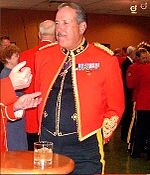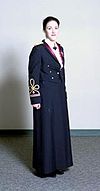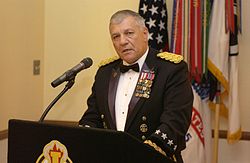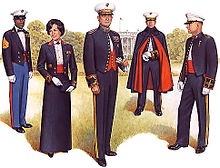- Mess dress
-
Mess dress is the military term for the formal evening dress worn in the mess or at other formal occasions. It is also known as mess uniform and mess kit. This style of military dress is largely restricted to the British, Commonwealth of Nations and United States armed forces; although the Imperial German and other navies adopted their own versions during the late nineteenth century, influenced by the Royal Navy.[1]
Contents
United Kingdom and Commonwealth
The Royal Navy and some other navies distinguish between mess dress, which is now the equivalent of civilian white tie, and mess undress, which is the equivalent of black tie.
Before 1939, there were three forms of evening dress:
- Ball dress (no. 2) - undress tailcoat, gold epaulettes, gold-laced trousers, white waistcoat, black bow tie, cocked hat
- Mess dress (no. 7) - mess jacket, gold-laced trousers, blue waistcoat, black bow tie, cap
- Mess undress (no. 8) - mess jacket, plain trousers, blue waistcoat, black bow tie, cap
Today, there are only two forms of evening dress:
- Mess dress (no. 2A) - mess jacket, plain trousers, white waistcoat, black bow tie, cap
- Mess undress (no. 2B) - mess jacket, plain trousers, blue waistcoat or cummerbund, black bow tie, cap
Officers of the rank of captain and above wear gold-laced trousers (the gold-lace stripes are known as lightning conductors), and may wear the undress tailcoat (without epaulettes), with either mess dress or mess undress. The undress tailcoat is so named to distinguish it from the full dress tailcoat that was worn during the day with full dress (no. 1), which is worn in a modified form by admirals today as ceremonial day dress.
Both the undress tailcoat and the mess jacket are double-breasted, with peaked lapels and six gilt buttons, but cut to be worn single-breasted and fastened at the front with two linked gilt buttons. The undress tailcoat is fitted with scallop-flapped hip pockets with three gilt buttons on each pocket. Rank on the undress tailcoat and mess jacket are indicated by gold lace on the sleeves. When tropical rig is ordered, a white mess jacket is worn instead of the blue, with shoulder boards to indicate rank.
Mess dress and mess undress are today worn with a soft marcella-fronted shirt with a soft collar. Stiff marcella-fronted shirts and stiff wing collars were previously worn with all forms of evening dress, but were abolished first for mess undress, and finally in the mid-1990s for mess dress. Rear-admirals and above may continue to wear the stiff shirt and collar with mess dress. Traditionally, half wellington boots are worn with mess dress and mess undress, but today shoes are more common.
The optional outer garment worn with evening dress is the boat cloak, which is a knee-length navy blue cloak lined with white silk, with four gilt buttons and fastened at the neck with two gilt lions' heads joined with a chain.
Miniature medals are worn with both mess dress and mess undress, though previously medal ribbons only were worn with mess undress on routine occasions, e.g. by the Officer of the Day. Officers who are members of orders of chivalry wear their stars and ribands as appropriate.
Cummerbunds, which may be worn with mess undress instead of the blue waistcoat and with Red Sea rig (no. 2C), are frequently decorated with badges or colours appropriate to the ship or establishment in which the officer serves: e.g. HMS Glasgow - Black Watch Tartan, HMS Illustrious - Green with the ships logo in gold (three crossed trumpets), Royal Naval Engineering College - Engineers' purple with the RNEC lettering in gold.
British and Commonwealth Armies
Mess uniforms first appeared in the British Army in about 1845. The original purpose was to provide a relatively comfortable and inexpensive alternative to the stiff and elaborate full dress uniforms then worn by officers for evening social functions such as regimental dinners or balls.[2] With the general disappearance of full dress uniforms after World War I, mess dress became the most colourful and traditional uniform to be retained by most officers in British and Commonwealth armies. Immediately after World War II the cheaper "blue patrols" were worn for several years as mess dress, but by 1956 the traditional uniforms had been readopted.
The formal designation of the most commonly worn mess uniform in the British Army is "No 10 (Temperate) Mess Dress". The form varies according to regiment or corps, but generally a short mess jacket is worn, which either fastens at the neck (being cut-away to show the waistcoat — this being traditionally the style worn by cavalry regiments),[3] or is worn with a white shirt and black bow tie (traditionally the usual style for all other regiments, corps and services).[4] Since the regimental amalgamations of recent years, the "cavalry style" jacket has been adopted by some British Army regiments and corps, such as the Adjutant General's Corps and the Royal Logistic Corps. Officers of the Brigade of Guards still wear the "infantry style" of jacket; as do others including the Royal Engineers, the Parachute Regiment, the Royal Army Medical Corps and the Royal Regiment of Scotland. In addition, the simpler "infantry style" uniform remains popular in Commonwealth armies.
The colours of mess jackets and overalls reflect those of the traditional full dress uniforms of the regiments in question, as worn until at least 1914. Jackets are therefore usually scarlet, dark blue or rifle green, with collars, cuffs, waistcoats or lapels in the former facing colours of the regiments in question. In the case of those regiments which have undergone amalgamation features of the former uniforms are often combined. Waistcoats (vests) are often richly embroidered, though with modern modifications, such as a core of cotton for gold cording instead of the thick gold cord[5] which made these items very expensive prior to World War II. Non-commissioned officers mess dress is usually simpler in design but in the same colours as officers of their regiment.
Most British Army regiments' mess dress incorporates high-waisted, very tight trousers known as "overalls", the bottoms of which buckle under leather Wellington or George Boots. Ornamental spurs are usually worn in cavalry regiments; some other regiments and corps prescribe spurs for field officers, since in former times these officers would have been mounted. The Rifles do not wear spurs at any rank due to the Light Infantry traditions, since historically no Light Infantry officer rode on horseback.[6] Scottish regiments wear kilts or tartan trews, and some wear tartan waistcoats as well.
In "No 11 Warm Weather Mess Dress" a white drill hip-length jacket is worn with either a waistcoat in the same material or a cummerbund of regimental pattern. Blue and various shades of red or green are the most common colours for the cummerbund. Trousers or overalls are the same as in No 10 Dress.[7]
Female officers and soldiers wear scarlet or blue "cavalry style" mess jackets resembling those of their male counterparts over dark coloured, ankle length, evening dresses. Black hand bags can be carried and black evening shoes are worn.
White tie is obtained from mess kit usually by wearing a detachable, wing-collar dress shirt, gold shirt studs, a white dress waistcoat and often white cotton gloves. The black bow tie is retained.
Royal Air Force
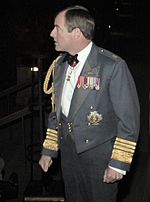 Sir Glenn Torpy wearing No. 5B Mess dress.
Sir Glenn Torpy wearing No. 5B Mess dress.
No.5 Mess dress in the Royal Air Force is similar to that in the Royal Navy, except that the jacket and trousers are in mid-blue. For the most formal occasions, such as court balls and royal evening receptions, a white bow tie is worn with a white waistcoat. However for all other evening events, a black bow tie with a mid-blue waistcoat (No. 5B) or a slate grey cummerbund (No.5) is worn. Cummerbunds of a particular squadron or unit design may also be worn. A further variation is the No.5A which has a white waistcoat and white bowtie. Among Scottish based units, a kilt of grey Clan Douglas tartan was initially authorised, but the recently[when?] approved official RAF tartan is now authorised.[8] A variation of No.1 SD is also permitted, when the usual blue shirt and black tie are replaced with a white shirt and black bow tie. This dress is referred to as No.4 Mess Dress.
Australian Army
The Australian Army has mess kits for summer and winter. The summer mess kit is a white jacket, almost identical between different parts of the army. The winter mess kit is made of thicker material, with jackets coloured by the wearers' Corps. The winter mess dress includes a waistcoat. Both kits have the same trousers, but trousers vary slightly between Corps. Women's mess attire is the same except that women wear a skirt instead of trousers. Both versions have a bow-tie and white shirt.
Australian Police Forces
Members of the Australian Federal Police, New South Wales Police Force, Victoria Police & South Australia Police wear Mess Dress on formal dining in nights.
Generally there is consistency between the mess dress uniforms of the various Australian Police forces and designs are similar. The New South Wales Police Force Mess Jacket is Navy Blue with cobalt blue cuffs and lapels and silver accoutrements. Miniature medals are worn.
United States
The use of mess dress in the United States Armed Forces is a more recent trend, which started in the early 20th century.
U.S. Army
In 1902, when the U.S. Army adopted its last standing collar blue uniform for full dress, a modified form of civilian "tail coat" was also introduced for evening dress, worn with a white tie and vest. This was known as the special uniform for evening wear. At the same time a mess uniform resembling the British pattern was authorized for less formal evening occasions. The short mess jacket was either dark blue or white according to climate. After 1911 the blue jacket included lapels in branch color (yellow for cavalry, red for artillery, light blue for infantry etc.). The individual officer had the option of either wearing full dress or either of the evening dress alternatives for social functions. In view of the expense involved it was usually senior officers who appeared in mess or evening dress uniforms. While the blue full dress was worn during 1902-17 by all ranks for ceremonial parades within the continental USA, the two optional evening uniforms were authorized only for officers.
The various blue uniforms ceased to be worn after 1917. However, the white mess uniform for commissioned and warrant officers was authorized again in 1921. In 1928, wearing of the full range of blue dress uniforms was authorized for all ranks but only when off duty and at the expense of the individual. In practice this meant that only the pre-1917 mess uniform and, to a lesser extent the special evening wear, reappeared in significant numbers.
After World War II, the evening dress and mess dress uniforms were reintroduced, with the "tail coat" having a single Austrian knot over the branch-of-service color (General Officers had stars over an oak-leaf braid), with the rank placed in the bottom opening of the knot, while the mess jacket, intended for black-tie occasions, used an Austrian knot (trefoil) rank system, with the branch insignia at the bottom. The number of knots indicated the officer's rank: five for Colonel, four for Lt. Colonel, three for Major, two for Captain, one for First Lieutenant, and none for Second Lieutenant. This complicated system was replaced with the evening coat style (which lost its "tails" in the late 1960s) in 1972, using a single knot and the rank placed above the branch-of-service color. A white mess jacket, for summertime wear, was introduced in the 1950s.
The special evening dress or tail coat finally disappeared in 1975, replaced by the Army Blue Mess uniform, which in its modern form closely resembles that of 1911.
Often confused with the Army White Mess Uniform, the Army White Uniform was used as a service, informal, and formal dress uniform equivalent to the Army Green Class A, Army Blue and Army Dress Blue Uniforms. The Army White Uniform will no longer be authorized for wear as of 1 October 2013. The Army White Mess and White Evening Mess Uniforms are still authorized for wear during specified seasons and in the tropics.
It is also common for soldiers to wear suspenders in their branch color with the Army Dress Uniform trousers.
U.S. Marine Corps
The United States Marine Corps, since the late 19th Century, has worn the most elaborate of the mess dress uniforms in the US Armed Forces. Mess dress is reserved for Staff NCO and officers; junior enlisted wear dress blues.
The uniform coat is fastened at the neck, similar to that of the Dress Blue uniform, but is cut away, cavalry style, to expose the shirt and scarlet cummerbund (General Officers have a scarlet vest with small gold buttons). Rank, in gold or silver wire, is embroidered directly on the shoulder epaulets, which are bordered with gold wire and scarlet piping. The collar and cuffs are also bordered in gold wire and scarlet, bearing a quatrefoil for Warrant Officers and company-grade officers, a single row of oak leaves for field officers, and a double row of oak leaves for flag officers. The uniform is completed with midnight blue trousers with gold & red stripes, with an optional wool "boatcloak" - a midnight blue knee-length cape lined in scarlet silk.
Staff Non-Commissioned Officers (Staff Sergeant to Sergeant Major/Master Gunnery Sergeant) wear a mess uniform similar to that of the Navy's officers, except with the standard dress blue trousers with "blood stripe," scarlet cummerbund, and black bow-tie. A white vest, for all officer ranks, and the white bow-tie and vest, for SNCOs, is worn for evening dress functions. A summer white mess dress, similar in design to the U.S. Navy/U.S. Coast Guard uniforms, but with shoulder epaulets instead of rank boards, was worn until the mid-1990s, when it was phased out.
Officers and Chief Petty Officers of the U.S. Navy and U.S. Coast Guard, United States Public Health Service Commissioned Corps, NOAA Corps, and Merchant Marine utilize the same mess uniform, referred to as "dinner dress". There are three styles of this uniform—Dinner Dress, Dinner Dress Jacket, and Tropical Dinner Dress.
Dinner Dress uniforms, Blue and White, are modifications of Service Dress Blue or Service Dress White uniforms, but service ribbons and breast insignia are replaced with miniature medals and miniature breast insignia. Additionally, officers and chief petty officers wear an evening shirt and black bow tie with Dinner Dress Blue.
Dinner Dress Blue Jacket and Dinner Dress White Jacket consist of a black waist-length jacket with gold buttons (officer) or silver buttons (petty officer first class and below). Bullion or imitation bullion rank stripes are worn on the sleeves of the officers' blue jacket, and rating badge and service stripes are worn by enlisted personnel. On the officers' dinner dress white jacket, hard shoulder boards are worn. A gold cummerbund is worn by officers and chief petty officers, a black one by petty officers first class and below. Shirt studs and cuff links are gold for officers and chiefs, silver for petty officers first class and below. Hat or cap is not required with dinner dress jacket uniforms, but may be worn. For both genders it must be worn with an outer garment, which is traditionally the boat cloak for males and cape for females. Females do not need to remove headgear indoors when wearing the tiara. The boat cloak, tiara, and cape, all being optional items, are very rarely seen.[9][10]
Tropical Dinner Dress Blue incorporates Service Dress Blue trousers, Summer White (short sleeve) shirt, appropriate cummerbund, and miniature medals and breast insignia.
An additional uniform, Formal Dress (White Tie), is optional for all commissioned officers but may be prescribed for captains and above. This uniform is worn as an equivalent to civilian white tie dress. It is almost identical to Dinner Dress Blue Jacket except that a wing collar shirt, white waistcoat, and white tie are worn. A formal blue tailcoat may also be prescribed.[11]
Members of the U.S. Coast Guard Auxiliary wear the same uniforms, but with a silver cummerbund and Coast Guard Auxiliary officer insignia in place of the gold insignia. Petty Officers and below may, at their option, wear this same uniform but with a black cummerbund and silver buttons.
U.S. Air Force
In the 1950s and 1960s, the U.S. Air Force formal uniform consisted of a civilian black tailcoat with military sleeve braid and rank insignia added. It could be worn as either a black tie or white tie combination. Due to the tails, it was not considered a Mess Dress uniform.
The original U.S. Air Force mess dress consisted of a short black jacket with black trousers, with a white jacket for summer wear. The jackets had satin lapels with matching satin sleeve braid. It entered service in the 1970s and was phased out in the 1980s. It is still sometimes worn by retired officers. The current mess dress is similar in cut and tailoring but in a dark blue color for year round wear.
The current pattern was introduced in 1981 and is also similar to the RAF design, except that coat and trousers are dark blue. Dark blue bow ties and dark blue cummerbunds are used for black tie affairs, and white bow ties with white waistcoats for white tie affairs. Silver trimmed shoulder boards and silver sleeve braid are worn rather than rank braids (enlisted members wear sleeve rank insignia instead of shoulder boards, and no silver sleeve braid), along with silver buttons. No cover (hat) is worn. General officers have solid silver shoulder boards and wider silver sleeve braid. Enlisted members also have the option to wear the Semi-Formal Uniform, essentially an issued service dress with a white shirt substituted for the blue shirt, but many non-commissioned officers elect to purchase a mess dress. Women's Mess Dress uniforms have a long skirt replacing the trousers and delete the button chain clasp for the coat.
Israel
In the Israel Defense Forces (IDF), mess uniform is never actually worn inside Israel. It is only worn abroad, either by a military attaché or by senior officers on official state visits. These rules also apply to IDF dress uniform.[citation needed] Because of the small number of uniforms required they are tailor made for the specific officer.[citation needed]
The mess uniforms have a summer version and a winter version.
Pakistan
In the Pakistan Defence Forces, mess uniform is only worn for high-level evening events. The style of the Pakistani mess dress largely resembles that of the British Armed Forces. Mess uniform is worn by Pakistani military officers posted abroad, either as Military attachés (Air attaché, Naval attaché, Defence attaché) or by high-ranking officers on official State visits. Senior military officers, such as 1 to 4 star officers, are required to wear mess dress on appropriate occasions during such visits or while attending State Inaugurations. All mess uniforms are tailor made for specific officers according to their assignments and ranks.
References
- ^ Richard Knotel, pages 442 - 445 "Uniforms of the World - a Compendium of Army, Navy, and Air Force Uniforms 1700-1937", ISBN
- ^ W.Y. Carman, page 90 "A Dictionary of Military Uniform", ISBN 0-684-15130-8
- ^ Michael Barthorp, page 173, "British Cavalry Uniforms since 1660", ISBN 0 7137 1043 8
- ^ Sections 578 - 582, "Dress Regulations for the Army 1900" Her Majesty's Stationery Office 1900
- ^ Tim Newark, page 129 "Brassey's Book of Uniforms", ISBN 1 85753 243 0
- ^ http://www.army.mod.uk/documents/general/Rifles_Dress_Guidance_2011_Srl_1.pdf
- ^ Michael Barthorp, page 137, "British Infantry Uniforms since 1660", ISBN 1 85079 009 4
- ^ "Royal Air Force Tartan". kamrafa.co.uk. http://www.kamrafa.co.uk/. Retrieved 2009-08-08.
- ^ http://buperscd.technology.navy.mil/bup_updt/508/unireg/chapter3/uniformsMenu.htm
- ^ http://twoblacktires.blogspot.com/2009/03/fractured-prune-and-arlington-uniform.html
- ^ "United States Navy Uniform Regulations-Tailcoat, Formal, Blue (Male Officers)". http://buperscd.technology.navy.mil/bup_updt/508/unireg/chapter3/3500_seriesArticles/3501_85.htm. "This coat may be prescribed for males, captains and senior, to meet certain unique protocol requirements."
Categories:- Military uniforms
- Suits (clothing)
- American military uniforms
- History of clothing (Western fashion)
- History of fashion
Wikimedia Foundation. 2010.


